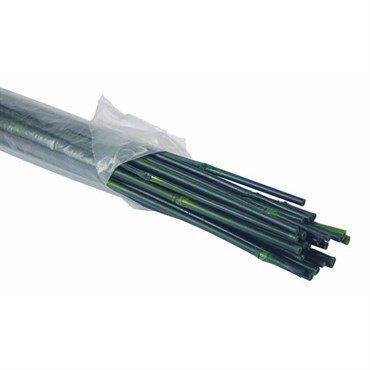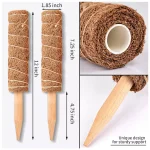Bamboo Plant Support Stakes
$9.99
Bamboo
Discount per quantity
| Quantity | 3 - 8 | 9 - 14 | 15+ |
|---|---|---|---|
| Price | $9.69 | $9.39 | $8.99 |
| % Discount | 3% | 6% | 10% |
Description
Bamboo Plant Support Stakes: A Friendly Guide for Strong, Happy Plants
Welcome to the World of Bamboo
We all want plants that stand tall and proud. But heavy blooms, gusty winds, and fast growth can make even the strongest stems bend. That is where bamboo plant support stakes step in. These slender poles look simple, yet they bring steady strength, gentle style, and earth-friendly charm to gardens big and small. In other words, they give structure without stealing the show. Let’s explore why bamboo stakes belong in your gardening toolkit and how you can use them with confidence.
1. What Are Bamboo Plant Support Stakes?
Bamboo stakes are straight pieces of bamboo cut to size and smoothed for safe handling. Each pole comes from the hollow, jointed stem of the bamboo grass. Because bamboo grows fast, there are many diameters and lengths to choose from. You will see skinny sticks for seed trays, thick poles for fruit trees, and every size in between. The outer layer feels hard like wood, but the core stays light, making each stake easy to lift, carry, and set.
- Key parts: nodes (raised rings), internodes (smooth sections), cut ends
- Common sizes: 2–8 ft tall, ¼–1 in thick
- Natural finish: pale tan that blends with leaves and bark
When you place a bamboo stake by a plant, you give that plant a spine. The stem can then climb, lean, or rest against the stake instead of drooping to the ground.
2. Why Choose Bamboo?
Instead of metal or plastic, many of us reach for bamboo. Here’s why:
- Green choice. Bamboo is a renewable resource that regrows after harvest. No heavy mining or long-life plastic here.
- Strong yet light. You get steel-like tensile strength without the weight. Moving a bundle is easy on backs and knees.
- Gentle on stems. The smooth surface rubs less than rough wood or wire, so stems stay unbruised.
- Budget friendly. Most packs cost less than equivalent metal rods.
- Looks natural. Tan poles fade into the background while letting foliage shine.
After more than one season, you will notice that bamboo stakes match almost any garden style, from cottage beds to sleek balcony pots.
3. Where and When to Use Bamboo Stakes
Bamboo stakes are as flexible in use as they are in form. Let’s see where they shine.
Vegetable Patches
- Tomatoes. Tie the main stem every 8 inches for straight, upright growth.
- Beans and peas. Create teepees or rows for vines to twine around.
- Peppers and eggplants. One stake keeps fruit-laden stems from snapping.
Flower Borders
- Dahlias and lilies. Tall blooms stay visible, not toppled.
- Snapdragons and delphiniums. Slender stakes prevent mid-storm flops.
Indoor Pots
- Monstera and philodendron vines. A single stake or trio guides aerial roots upward.
- Orchids. Short sticks hold bloom spikes just where you want them.
Young Trees and Shrubs
Place three sturdy bamboo poles around a new tree to keep its trunk steady until roots anchor firmly.
4. How to Select the Right Stake
Picking the right stake feels simple, but a few quick checks help you buy once and use for years.
- Match height. Choose a stake that reaches at least two-thirds of the plant’s expected full height.
- Check thickness. Heavy stems need thicker poles. For tomatoes, ½-in diameter is fine. For dwarf fruit trees, go ¾ in or more.
- Inspect quality. Look for smooth outer skins, no deep cracks, and clean cuts. A tight outer skin protects from rot.
- Heat-treated? Heat or flame-cured stakes last longer by sealing sugars that bugs crave.
- Straight lines. Eye down the length. A bend may be pretty in art, but it weakens support.
In short, stronger plants want sturdier stakes, and taller plants prefer longer ones.
5. Preparation Before Installation
We all enjoy quick wins, but a minute of prep saves hours later.
- Clean ends. Sand sharp edges so they do not slice stems.
- Measure twice. Know how deep your stake will sit. A third of the pole should go in the soil for firm footing.
- Soften soil. Water the ground lightly or use a dibber to open a pilot hole. That way the stake slides in without hammer blows.
- Gather ties. Have soft twine, cloth strips, or stretch-tie ready. Rough rope can cut fleshly stems.
- Think angle. For windy spots, angle stakes slightly into the prevailing wind. This helps balance push and pull forces.
Instead of rushing, pause and lay out everything near the plant. You will finish faster and gentler.
6. Step-by-Step Installation Guide
Single Stake Method
- Insert the stake about 2 inches from the plant’s base.
- Push straight down until the buried end feels solid.
- Tie the main stem loosely with a figure-eight loop. The stem sits on one side of the loop, the stake on the other.
- Add more ties every 6–10 inches as the plant grows.
Teepee Support
- Gather three or five equal-length poles.
- Push ends into a tight circle around seedlings.
- Draw tops together and lash with twine.
- Train vines to twine around each leg.
Horizontal Trellis Frame
- Drive two tall stakes at row ends.
- Lay slim poles or twine between them at spaced heights, making a ladder.
- Tie joints where poles cross for stiffness.
- Guide climbing beans or cucumbers along rungs.
Grid System for Raised Beds
- Place a stake every 12–18 inches along bed edges.
- Weave long canes through uprights to form a grid.
- Plants lean on whichever bar sits nearby, spreading weight evenly.
Indoor Pot Support
- Push a thin stake down the pot’s center without disturbing roots.
- Secure vine stems with soft plant tape.
- Rotate the pot weekly so all leaves see light and grow evenly around the pole.
In other words, build the frame that best matches each plant’s shape.
7. Caring for Your Bamboo Stakes
Good care keeps stakes sturdy and clean for seasons.
- Check ties often. Loosen them before they dig in. Stems swell faster than you think.
- Watch for rot. If the buried end feels mushy, trim it back or swap the pole.
- Clean between uses. Wipe soil off with a damp rag, then air-dry flat.
- Store dry. Lay bundles in a shed or hang from hooks. Avoid damp floors that breed mold.
- Seal ends. Dip tips in melted wax or safe wood sealer to slow moisture entry.
- Rotate poles. Use older stakes for lighter tasks and save fresh, strong ones for top-heavy crops.
After more than three seasons, toss cracked or splintered stakes into compost or a brush pile. They will break down and return to soil.
8. Supporting Specific Plants
Tomatoes
Tie the main stem every hand-span. Remove lower leaves to boost air flow. If the plant outgrows one pole, lash a second stake nearby and add a cross brace.
Peppers and Eggplants
Insert small stakes right after transplant. This prevents early wind damage. As fruit sets, add a second tie under each heavy cluster.
Cucumbers
Use a teepee or frame. Guide vines upward so fruit hangs down, straight and easy to pick.
Climbing Flowers
Morning glories, sweet peas, and nasturtiums spin around stakes on their own. Place poles before seeds sprout to avoid root disturbance.
Houseplant Vines
Wrap aerial roots of pothos or monstera around a stake covered with moist moss. The roots grip the damp surface and climb higher, making big, lush leaves.
9. Troubleshooting Common Problems
Leaning stakes. Push the pole deeper or tie a second stake on the windward side. Crossing two stakes adds leverage.
Rot at soil line. Apply a natural wood preservative like linseed oil before reusing. Or bury the pole inside a short piece of plastic pipe to keep it dry.
Splinters. Sand rough patches and wear gloves. Little hands can help in the garden but need safe surfaces.
Thin twine cutting stems. Switch to soft cloth or stretchy rubber ties. Leave a finger’s width between stem and stake.
Insect holes. Small borers may attack old, damp stakes. Dry poles in the sun and store indoors over winter to deter them.
Instead of feeling frustrated, treat each issue as a chance to tweak your staking style.
10. Creative Uses Beyond Support
Bamboo stakes do more than hold plants upright.
- Row markers. Write crop names on small stakes with a waterproof pen.
- Garden art. Spray-paint poles and set them in patterns for bold accents.
- Birdhouse poles. Slide a tiny birdhouse onto a tall stake to greet feathered friends.
- DIY trellis. Lash canes into squares or triangles, then lean them against walls for climbing roses.
- Seasonal lights. Wrap fairy lights around a bamboo teepee for a soft evening glow.
But most of all, enjoy the freedom to invent. Bamboo bends to your vision.
11. Sustainability Spotlight
Growing bamboo takes little water, no fertilizer, and only a few years to mature. Harvesters cut mature culms and leave root systems intact, so new shoots sprout quickly. That speedy cycle locks carbon, supports rural economies, and eases pressure on slow-growing trees.
When a stake reaches the end of its life, you have choices.
- Compost. Chop the pole into short pieces. They break down faster.
- Biochar. Burn old stakes in a low-oxygen barrel. The resulting char enriches soil.
- Crafts. Turn dry canes into baskets, frames, or tool handles.
By reusing and recycling, we close the loop and honor the material.
12. Safety Tips
- Wear gloves when cutting or sanding stakes.
- Use pruning shears, not dull kitchen scissors, to trim ends.
- Insert poles slowly to avoid stabbing hidden irrigation lines.
- Keep extra-long stakes away from power lines during setup.
- Teach children to respect pointed tips. Blunt ends with a quick sanding.
Simple care keeps every gardener safe and smiling.
13. Frequently Asked Questions
How long will my bamboo stakes last?
On average, two to four seasons outdoors. Thicker poles and careful storage stretch life further.
Can I paint or seal them?
Yes. Use non-toxic outdoor paint or natural oils. Paint adds color; oil adds water resistance.
Will bamboo mold indoors?
If kept dry, no. Wipe off moisture and ensure airflow. For moss poles, mist only the moss, not the bare bamboo.
Do I need to remove stakes in winter?
In freezing zones, pull thin stakes that may crack under snow load. Sturdier poles can stay—just check for damage in spring.
Is bamboo stronger than wooden dowels?
In tension, yes. Bamboo’s fibers run lengthwise, giving it amazing pull strength. Wood can be tougher in compression, but bamboo wins on weight-to-strength.
14. Step Up Your Garden Game
Bamboo plant support stakes prove that small tools can make a giant difference. They lift sagging stems, guide climbing vines, and let every leaf catch sunlight. They also show how natural materials can solve modern gardening needs without fuss.
Now that we have walked through choosing, using, and caring for bamboo stakes, you hold the knowledge to help your plants stand tall. Gather a bundle, feel their light weight, and picture the sturdy scenes you will build. Together, we can shape gardens that look good, feel good, and treat Earth kindly.
Evergreen Encouragement Ahead
May each stake you set become a quiet hero, raising blooms to bright skies and veggies to eager hands. Let’s keep learning, keep growing, and keep sharing sturdy bamboo wisdom—season after season, garden after garden.
Additional information
| Weight | N/A |
|---|---|
| Item Size | 25 count Green – 18 inches |



